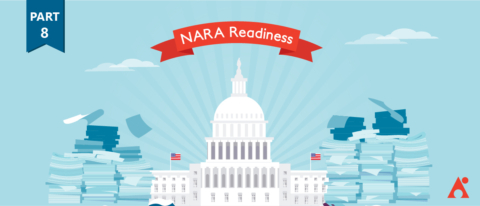Should All Content Be Classified as a Record? (NARA Series #8)


Need comprehensive federal records management tools? Download our free NARA compliance resource kit today!
This is the eighth entry in our NARA series. Check out the others below!
- The Reports That Records Managers Can’t Live Without
- 7 Simple Steps Records Managers Can Take to Develop a Risk/Value Framework
- Retain or Destroy? How to Make Tough Records Management Decisions
- How to Start Optimizing Email Records Management ASAP
- Email Records Management Done Right: A Walkthrough of NARA’s Guidelines
- 3 Clear-Cut Ways to Get Executive Buy-In on Your Records Management Initiative
-
How to Find a Records Management Solution That Works for You, Not Against You
It used to be that a record was easy to define: content created on carbon paper and perpetually stored in a filing cabinet. It’s no official definition, but it was a concept that anyone could understand. And we used to create records at a pace where it was, for some time, manageable.
Over the years the definition of a record has morphed. As of 2014, the Federal Records Act defines a record as including “…all recorded information, regardless of form or characteristics, made or received by a Federal agency under Federal law or in connection with the transaction of public business.” As of 2017, ARMA International listed a record as “…recorded information, regardless of medium or characteristics, made or received by an organization in pursuance of legal obligations or in the transaction of business.” Cut and dry, right? Well, dry, at least.

Where do these definitions leave the records manager and mission worker (often called knowledge worker or end user) in identifying records? Can they answer:
- Is my content a record?
- Where should I store my records?
- Do I have to classify everything I work on?
- Can I share this?
- Can I delete this?
In March, the Digital Government Institute held its annual eDiscovery, Records, and Information Management Conference. In response to a question about electronic chat history, a NARA spokesperson stated that “everything is a record.” Every. Single. Thing.
More specifically, if content is created in the act of doing business, that content is a record. By this definition, records can include:
- An electronic conversation between coworkers
- A document in draft or final PDF form
- An information graphic
- Training materials
- A tweet from Twitter or snap from SnapChat
So, is your content a record? Yes! All content is a record.
Let that sink in: IBM estimates that by 2020 humanity will annually create more than 10x (35 zettabytes) the amount of data than that which existed in 2012 (2.7 zettabytes). That means in a year your organization, agency, or department has likely created more information than it has in its entire history. And all of that information are records.
Need to change up your records management approach? Check out this post: Click To TweetWhy it Matters
A record is evidence that at some point in time information was created; it must be discoverable. eDiscovery teams are looking for tools to index entire data systems, not just the records solution. FOIA requests don’t ask for records; they ask for all information related to a particular event. Frankly, an “Electronic Records Management solution” is a misnomer; it should be an “Information Management solution.” All information should have management around it from the time of creation, should be treated as a record, should have disposal guidelines in place and, more importantly, retention policies applied to it.
And therein lies the rub. It is no more possible to expect a mission worker to be able to keep up with the myriad of mandates and laws that govern their work than it is to expect a lone records manager to be able to tag and classify all information as it is created. This doesn’t mean that records management has to be exponentially harder, but it does mean that we need to consider it differently.
If your information is important enough to save,
we think it’s important enough to be managed.
Here are six steps to change your approach to records information management to ensure that your agency can successfully meet NARA’s records mandates:
1. Understand the requirements to develop the right strategy
Once you’ve changed your organizational definition of a record, it’s time to understand how to govern them. Dissect the NARA mandates and identify any other regulations which will govern your specific mission data. This is the baseline on which your entire records program will be developed. Click here for more info.
2. Clean up the clutter
Records disposal is just as important as retention because sitting on content that you could have or should have deleted can lead to serious consequences. “Marie Kondo” your records by understanding the disposition authorities which govern your agency and developing a file plan to support manual and automated destruction where appropriate. Click here for more info.
3. Develop a Risk/Value framework
Support content disposal and feel confident that your records are properly stored and secured by utilizing a solid risk/value framework. Click here for more info.

4. Engage the right sponsors to gain buy-in
Across the federal government, the NARA records mandates remain unfunded while end-users fight to keep from having information management policies thrust upon them. Finding the right sponsor will lend authority to the records management initiative, aiding in developing funding for tools and deployment and providing a voice from which end-users can understand the value that the initiative will provide towards mission success. Click here for more info.
5. Find and deploy the right tools to meet YOUR needs
While there are common rules across the federal government, not every agency has the same needs. Additionally, a records manager is rarely a software expert, nor does a technologist understand the rules and regulations governing your agency. The right technology will support the records manager in defining these rules in easy to deploy (and easy to manage) methods. Identifying and deploying the right tools for your collaboration (and email) information management needs is key to successfully meeting NARA’s mandates. Click here for more info.
6. Ensure you can report on the right information
Last, but certainly not least, a records manager will live in reporting. Your solution must provide an audit trail showing who changed what within your file plans as well as what content is due for disposal and who approved it. Understanding your reporting needs prior to selecting a tool will ensure that your agency always has the information required to stay on top of the latest mandates and regulations. Click here for more info.
Hungry for more NARA advice and coverage? Be sure to subscribe to our blog!

I sell software, but my passion is to help translate the needs of the business into the capabilities of available technology. Over two decades in tech I have helped customers analyze collaboration solutions against actual mission needs in helping them select the best path based on their personal critical success factors. Per my training I’m a project manager (PMP), an engineer, an architect, and a designer; but ultimately, I’m a problem solver.


